Christmas
Christmas in Valencia, as in many parts of Spain, is a blend of religious traditions, festive events, and gastronomic delights. Here’s how Christmas is celebrated in Valencia:
Nativity Scenes (Belenes)
One of the most cherished traditions is the setting up of ‘Belenes’ or nativity scenes. These can range from small setups in homes to large, intricate displays in public squares, churches, and other public venues. Some scenes even include moving parts and detailed recreations of entire villages.
Christmas Markets
Valencia hosts several Christmas markets, with the most notable being the one in the central square. These markets sell everything from Christmas decorations and crafts to traditional festive foods.
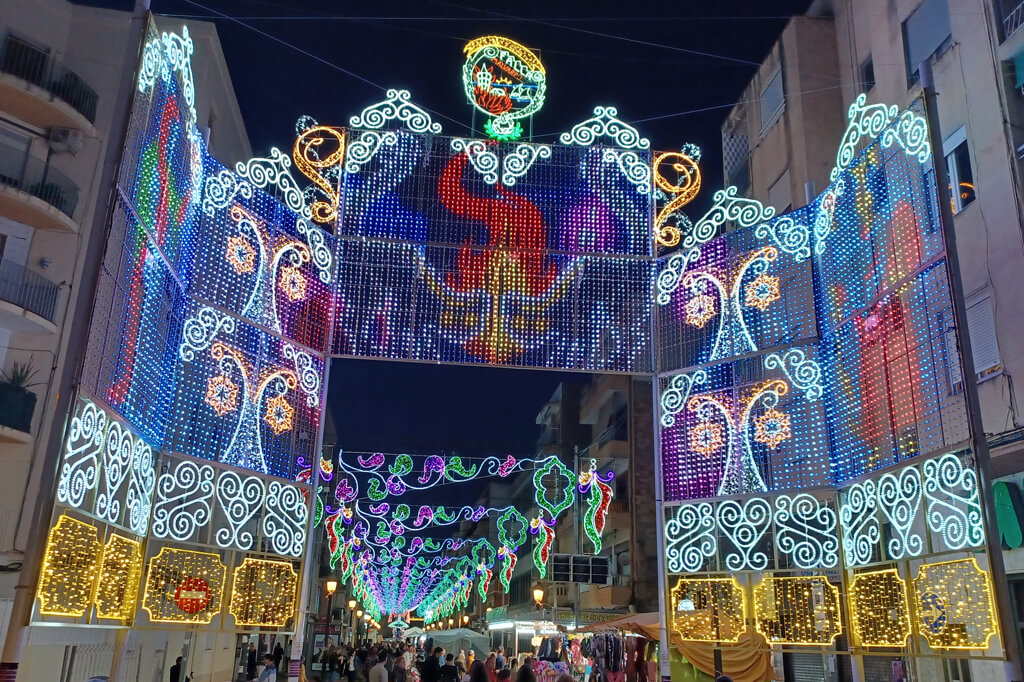
Gastronomy
Food plays a significant role in Valencian Christmas celebrations. Traditional dishes and sweets include ‘turron’ (a type of nougat), ‘marzipan’, ‘polvorones’ (almond cookies), and ‘rosquilletas’ (sugar-coated pastries). On Christmas Day, families often gather for a special meal that might include dishes like ‘paella’ or roasted meats.
Midnight Mass
Many Valencians attend the ‘La Misa del Gallo’ or the Rooster’s Mass at midnight on Christmas Eve. This tradition is so named because it’s believed that a rooster crowed on the night Jesus was born.
Cavalcade of the Magi
While Christmas Day is celebrated with enthusiasm, the real highlight for many, especially children, is the arrival of the Three Kings on January 5th. Valencia, like many Spanish cities, hosts a grand parade known as the ‘Cabalgata de Reyes’, where the Three Kings throw sweets and small gifts to the crowds.
Christmas Lights
The city is adorned with festive lights, and the streets come alive in the evenings with both locals and tourists strolling around, enjoying the illuminations.
Traditional Music and Dance
Throughout the festive season, it’s common to come across groups performing traditional Valencian music and dances in the streets.
Day of the Innocents
Celebrated on December 28th, this day is similar to April Fools’ Day in other cultures. People play pranks on each other, and it’s all in good fun.
Special Activities
Many museums and attractions in Valencia might have special workshops and activities for children during the Christmas season.
The blend of religious reverence, festive events, and the warmth of family gatherings makes Christmas in Valencia a unique and memorable experience.
New Year
New Year’s Eve, or “Nochevieja” as it’s known in Spanish, is a vibrant and festive occasion in Valencia, as it is throughout Spain. Here’s how Valencia rings in the New Year:
The 12 Grapes Tradition
One of the most iconic traditions in Spain during New Year’s Eve is the eating of 12 grapes at the stroke of midnight. As the clock chimes 12 times, one grape is eaten with each chime. This custom is believed to bring good luck for each month of the coming year. Many Valencians gather in public squares, especially around the City Hall, to participate in this tradition together.
Public Celebrations
The main squares of Valencia, particularly the Plaza del Ayuntamiento, become focal points of celebration. Crowds gather to watch fireworks, enjoy live music, and count down to midnight together.
Parties and Nightlife
After the public celebrations, many locals and tourists head to bars, clubs, and parties that continue well into the early hours of the morning. Special New Year’s Eve events are hosted by many venues across the city.
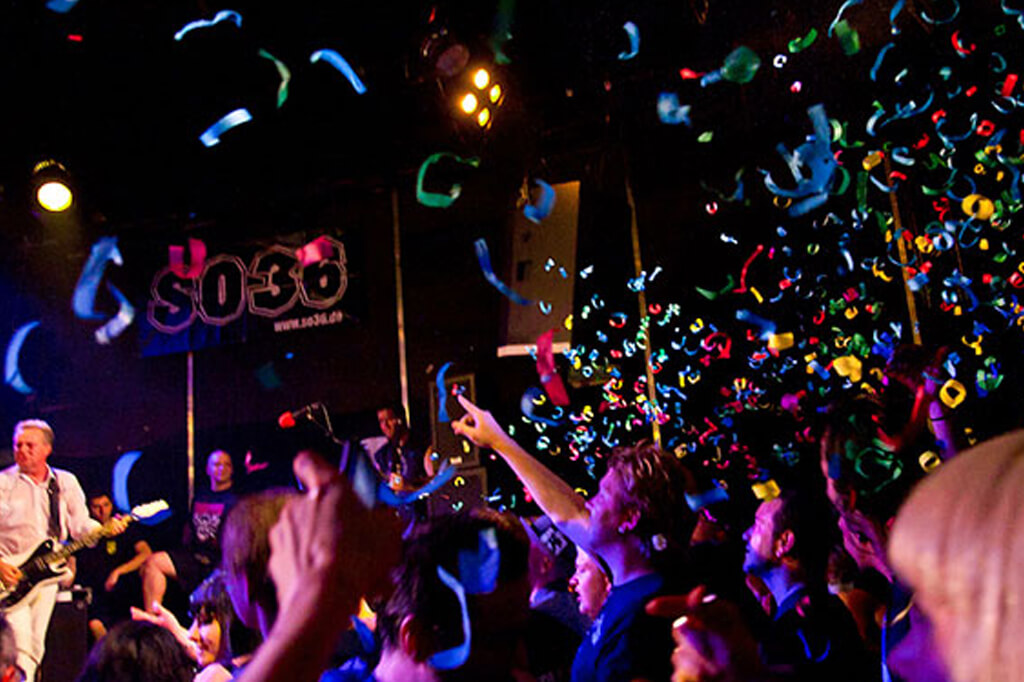
Cava Toast
Just as the clock strikes midnight, after the grapes have been consumed, it’s customary to toast the New Year with a glass of Cava, the Spanish sparkling wine.
Traditional Attire
Some people wear red underwear on New Year’s Eve as it’s believed to bring good luck in love for the coming year.
Day of the New Year
January 1st, known as “Año Nuevo”, is a public holiday and is generally a quiet day in Valencia. After the late-night festivities, many people spend the day resting, enjoying meals with family, or taking leisurely strolls in the city’s parks and along the beach.
Special Foods
Apart from the grapes, certain foods are considered lucky to eat during New Year’s celebrations. Lentils, for instance, are believed to bring prosperity and are often included in meals on New Year’s Eve or New Year’s Day.
Shopping
In the days leading up to New Year’s Eve, shops in Valencia are bustling with people buying festive attire, grapes, and other essentials for the celebrations.
Television Specials
Many families and groups tune in to watch special New Year’s Eve programs on Spanish television, which broadcast the chimes from the Puerta del Sol square in Madrid.
Good Wishes
It’s customary to wish each other “Feliz Año Nuevo!” which means “Happy New Year!”
The combination of traditional customs, public festivities, and private celebrations makes New Year’s in Valencia a memorable and joyous occasion.
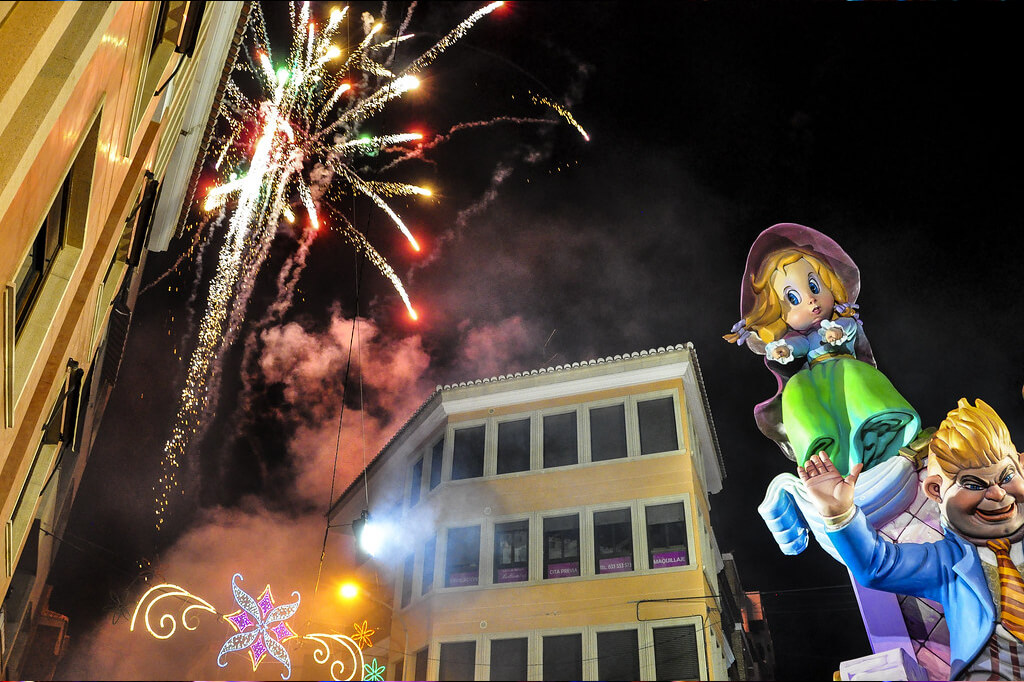
Easter
Easter in Valencia, as in the rest of Spain, is a deeply significant and widely celebrated occasion. Known as “Semana Santa” (Holy Week), it’s marked by a series of religious events, processions, and traditions that reflect the region’s rich cultural and religious heritage. Here’s how Easter is celebrated in Valencia
Processions
The most iconic aspect of Semana Santa in Valencia, as in other parts of Spain, is the religious processions. These are solemn, deeply emotional events where various religious brotherhoods (cofradías) parade religious statues depicting the Passion of Christ and the Virgin Mary through the streets. Participants, known as “nazarenos” or “penitentes”, often wear traditional robes and pointed hoods, which cover their faces except for their eyes.
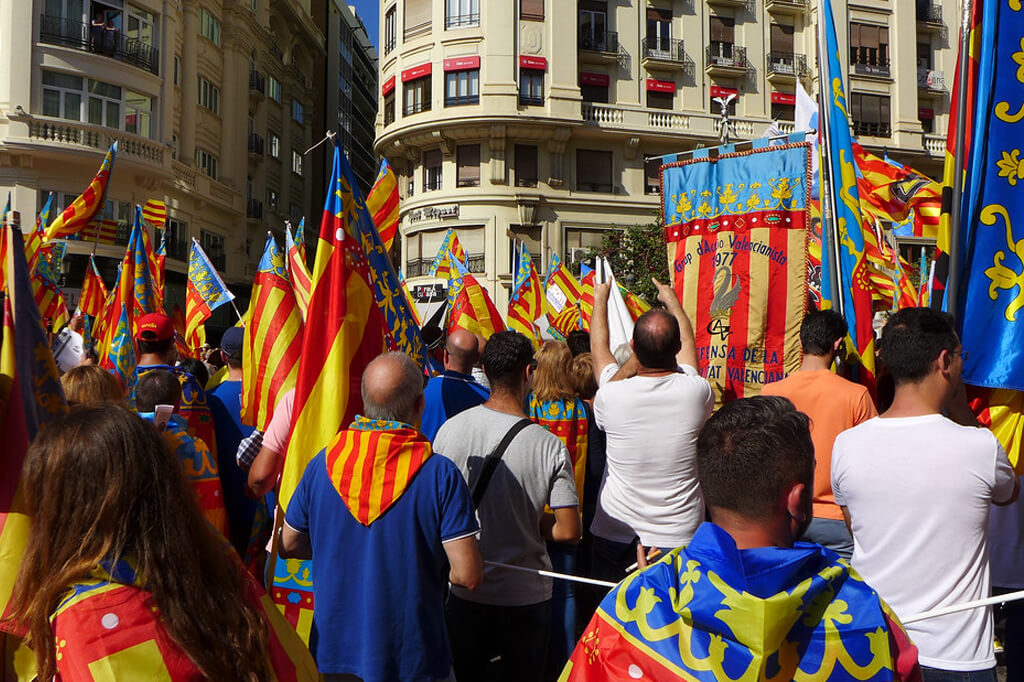
La Semana Santa Marinera
Valencia’s maritime district has its unique way of celebrating Easter called “La Semana Santa Marinera”. This version of Holy Week combines religious fervour with Mediterranean traditions. Processions here have a maritime theme, and some events even take place on the beach.
Dramatisations
In some areas, the events of the Passion of Christ are re-enacted. These dramatisations, which can be quite moving, depict scenes from the Last Supper, the Crucifixion, and the Resurrection.
Music
Traditional bands accompany the processions, playing sombre music that adds to the emotional atmosphere. The sound of drums and trumpets echoing through the streets is a hallmark of Semana Santa.
Traditional Foods
Easter in Valencia sees the preparation of special dishes and sweets. “Mona de Pascua” is a traditional Easter cake, often topped with a boiled egg or chocolate. It’s customary for godparents to gift this cake to their godchildren.
Easter Sunday
Known as “Domingo de Resurrección”, Easter Sunday is a joyous day celebrating the resurrection of Jesus. Bells ring out, and there are festive processions, contrasting with the sombre mood of the preceding days.
Lunes de Pascua
The Monday following Easter Sunday, known as “Easter Monday” or “Lunes de Pascua”, is a public holiday in Valencia. Families often head to the countryside or parks for picnics and to enjoy the spring weather.
Dress
During the processions and church services, many participants and attendees wear traditional attire. This can include women in mantillas (lace veils) and men in suits or traditional robes.
Church Services
Throughout Holy Week, churches in Valencia hold special services, masses, and vigils. The most significant is the midnight service on Holy Saturday, known as “La Vigilia Pascual”, celebrating the resurrection of Christ.
Cultural Events
Apart from religious events, Easter week is also a time for cultural activities in Valencia. Concerts, exhibitions, and other events are often organised, adding to the festive atmosphere.
Easter in Valencia offers a blend of deep religious devotion, cultural richness, and festive celebration, making it a unique and unforgettable experience for both locals and visitors.
Valentines Day
Valentine’s Day, known as “Día de San Valentín” in Spanish, is celebrated in Valencia similarly to many other Western countries, but with a touch of Spanish and Valencian flair. Here’s how Valentine’s Day is typically celebrated in Valencia:
Gifts
As in many places, it’s common for couples to exchange gifts. Popular gifts include chocolates, flowers (especially red roses), jewellery, and perfumes.
Romantic Dinners
Many couples opt for a romantic dinner in the city’s restaurants. Valencia, with its Mediterranean setting, offers a plethora of dining options, from traditional Valencian cuisine to more international fare. Seafood restaurants, in particular, are a popular choice.
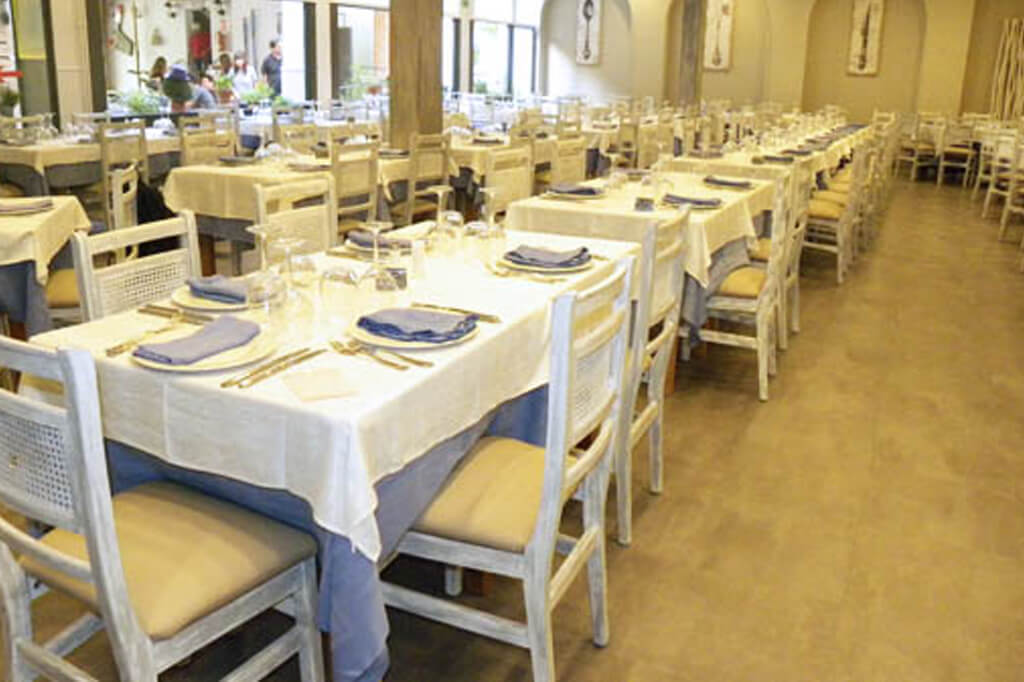
Strolls
Valencia’s beautiful historic centre, the Turia River Gardens, and the City of Arts and Sciences are favourite spots for romantic walks.
Special Events
Some local establishments and venues might organise special events or promotions for Valentine’s Day, including themed parties, concerts, or special movie screenings.
Weekend Getaways
Given that Valencia is located on the coast, many couples might choose to have a romantic weekend getaway in nearby coastal towns or countryside retreats.
Traditional Sweets
Spain has a rich tradition of confectionery, and for Valentine’s Day, many pastry shops and bakeries in Valencia might offer special heart-shaped or Valentine-themed treats.
Love Letters and Cards
While perhaps not as popular as in some other countries, it’s still common for lovers to exchange heartfelt letters or Valentine’s cards.
Cultural Activities
Couples might also choose to spend the day visiting a museum, attending a theatre show, or enjoying a live music performance.
Public Displays of Affection
Spaniards are generally open about showing affection. It’s not uncommon to see couples holding hands, hugging, or sharing a kiss in public places.
Shopping
Many shops and malls might have special Valentine’s Day sales or promotions, making it a busy shopping day as well.
While Valentine’s Day is widely celebrated, it’s worth noting that Spain has its own version of a ‘love day’ called “El Día de San Jordi” (St. George’s Day) celebrated on April 23rd, especially in Catalonia. On this day, it’s traditional for men to give women roses, and women to give men books. However, in Valencia, while San Jordi is recognised, it doesn’t overshadow Valentine’s Day’s popularity as a day of love and romance.
Halloween
Halloween, known as “Halloween” or “Noche de Brujas” (Night of Witches) in Spanish, has been gaining popularity in Spain over the last few decades, influenced by American culture. While it’s not a traditional Spanish celebration, many of its customs have been adopted and sometimes merged with local traditions. Here’s how Halloween is celebrated in Valencia.
Costumes and Parties
Just like in many other parts of the world, dressing up in costumes is a significant part of the Halloween celebration. Both children and adults don costumes, and many bars and clubs host themed parties on Halloween night.
Trick-or-Treating
Children, dressed in their Halloween costumes, go from door to door in their neighbourhoods asking for candy, similar to the “trick-or-treat” tradition. They often say “¿Truco o trato?” which is the Spanish equivalent of “trick or treat?”
Decorations
Shops, homes, and public places might be decorated with typical Halloween motifs like pumpkins, witches, ghosts, and cobwebs.
School Activities
Many schools organize special activities for children, such as costume contests, pumpkin carving, or storytelling sessions.
Tosantos
In some parts of Spain, the period around Halloween is known as “Tosantos.” While this tradition is more prevalent in regions like Andalusia, some of its customs, like making special pastries or sweets, can be found in Valencia.
All Saints’ Day
The day after Halloween, on November 1st, is “Día de Todos los Santos” or All Saints’ Day. It’s a public holiday in Spain, and it’s traditionally a day to remember and honour deceased loved ones. Many Valencians visit cemeteries to place flowers on the graves of their departed family members.
Chestnuts
Around this time, it’s common to find street vendors selling roasted chestnuts, a seasonal treat.
Horror Film Screenings
Cinemas might have special screenings of horror films, and some local cultural centres might organise horror film festivals or themed events.
Haunted Houses and Tours
Some places might set up haunted house attractions, and there might be guided tours that focus on the spooky or mysterious legends of Valencia.
Local Legends and Stories
Valencia, with its rich history, has its share of ghost stories and legends. Around Halloween, there might be special tours or storytelling sessions that delve into these tales.
While Halloween is becoming more popular, it’s essential to note that the more traditional and solemn All Saints’ Day still holds significant importance for many Valencians. The blend of festive Halloween celebrations with the reflective nature of All Saints’ Day creates a unique atmosphere in Valencia during this period.
